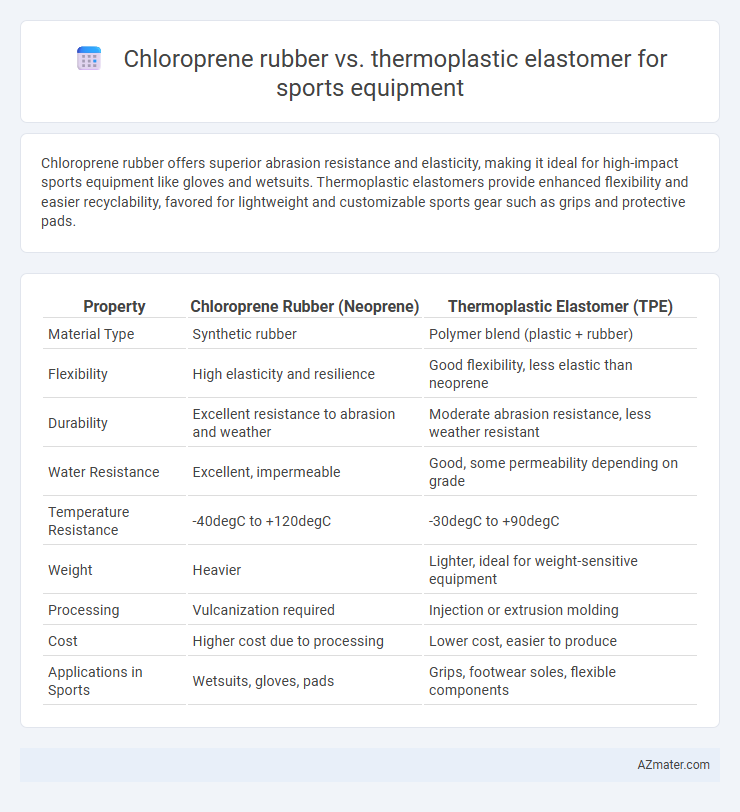Chloroprene rubber offers superior abrasion resistance and elasticity, making it ideal for high-impact sports equipment like gloves and wetsuits. Thermoplastic elastomers provide enhanced flexibility and easier recyclability, favored for lightweight and customizable sports gear such as grips and protective pads.
Table of Comparison
| Property | Chloroprene Rubber (Neoprene) | Thermoplastic Elastomer (TPE) |
|---|---|---|
| Material Type | Synthetic rubber | Polymer blend (plastic + rubber) |
| Flexibility | High elasticity and resilience | Good flexibility, less elastic than neoprene |
| Durability | Excellent resistance to abrasion and weather | Moderate abrasion resistance, less weather resistant |
| Water Resistance | Excellent, impermeable | Good, some permeability depending on grade |
| Temperature Resistance | -40degC to +120degC | -30degC to +90degC |
| Weight | Heavier | Lighter, ideal for weight-sensitive equipment |
| Processing | Vulcanization required | Injection or extrusion molding |
| Cost | Higher cost due to processing | Lower cost, easier to produce |
| Applications in Sports | Wetsuits, gloves, pads | Grips, footwear soles, flexible components |
Introduction to Chloroprene Rubber and Thermoplastic Elastomer
Chloroprene rubber (CR), also known as neoprene, is a synthetic elastomer renowned for its excellent resistance to weathering, oils, and heat, making it ideal for durable sports equipment like wetsuits and protective gear. Thermoplastic elastomers (TPE) combine the elasticity of rubber with the recyclability of plastics, offering lightweight and flexible properties suited for sports items requiring cushioning and impact absorption such as grips and padding. Both materials balance durability and performance, but chloroprene rubber excels in chemical and temperature resistance, while thermoplastic elastomers provide enhanced design versatility and ease of manufacturing.
Key Material Properties of Chloroprene Rubber
Chloroprene rubber (CR) exhibits excellent abrasion resistance, high tensile strength, and superior weatherability, making it ideal for sports equipment subjected to tough outdoor conditions. Its inherent oil and chemical resistance enhances durability, while good elasticity and resiliency provide comfort and shock absorption in athletic gear. These key material properties often make chloroprene rubber preferable over thermoplastic elastomers, which typically have lower resistance to harsh environments.
Essential Features of Thermoplastic Elastomer
Thermoplastic elastomers (TPE) offer superior flexibility, durability, and lightweight properties essential for high-performance sports equipment, enabling enhanced comfort and shock absorption. Their thermoplastic nature allows easy molding and recycling compared to chloroprene rubber, which is more rigid and less environmentally friendly. TPE's resistance to fatigue, UV radiation, and chemical exposure ensures longer lifespan and consistent performance in diverse sports conditions.
Durability Comparison in Sports Equipment Applications
Chloroprene rubber offers superior durability in sports equipment due to its excellent resistance to abrasion, weathering, and oil, making it ideal for high-impact applications like protective gear and athletic footwear. Thermoplastic elastomers provide flexibility and ease of processing but generally exhibit lower resistance to wear and environmental factors, limiting their longevity under intense, repeated use. For sports equipment demanding prolonged durability and toughness, chloroprene rubber is the preferred choice.
Flexibility and Comfort: Chloroprene Rubber vs TPE
Chloroprene rubber offers superior flexibility and resilience, making it ideal for sports equipment requiring durability and consistent performance under stress. Thermoplastic elastomers (TPE) provide enhanced comfort through their softer, more pliable texture and better cushioning properties, adapting well to ergonomic designs. For sports gear emphasizing flexibility and comfort, TPE often outperforms chloroprene rubber in softness, while chloroprene excels in long-term elasticity and environmental resistance.
Resistance to Environmental Factors: Water, Heat, and Chemicals
Chloroprene rubber offers superior resistance to water, heat, and a broad range of chemicals, making it highly durable for sports equipment exposed to harsh environments. Thermoplastic elastomers provide good flexibility and moderate resistance to environmental factors but may degrade faster under prolonged heat and chemical exposure. For applications requiring long-term performance and resilience against moisture, UV radiation, and oils, chloroprene rubber remains the preferred material.
Weight and Portability Considerations
Chloroprene rubber offers a denser, heavier composition that provides excellent durability and impact resistance, ideal for sports equipment requiring high toughness but may compromise portability. Thermoplastic elastomers (TPE) are significantly lighter and more flexible, enhancing ease of transport and handling without sacrificing moderate durability. Selecting TPE can improve athlete performance by reducing equipment weight, while chloroprene rubber is preferable when maximum robustness is critical.
Safety and Skin Compatibility in Sports Gear
Chloroprene rubber offers excellent durability and resistance to oils and UV radiation, making it highly safe for sports equipment that requires prolonged outdoor use. Thermoplastic elastomers provide superior skin compatibility due to their hypoallergenic properties and flexibility, reducing irritation during extended wear in sports gear like gloves and protective pads. Both materials contribute to safety, but chloroprene excels in environmental resilience while thermoplastic elastomers prioritize wearer comfort and allergic sensitivity.
Cost and Manufacturing Efficiency
Chloroprene rubber offers strong durability and excellent weather resistance but tends to have higher raw material and processing costs compared to thermoplastic elastomers (TPEs). Thermoplastic elastomers provide superior manufacturing efficiency through faster molding cycles and recyclability, reducing overall production expenses for sports equipment. Choosing TPEs often results in lower cost per unit and greater design flexibility, making them a preferred option for cost-sensitive sports gear manufacturers.
Which Material Is Best for Your Sports Equipment?
Chloroprene rubber offers superior resistance to abrasion, weathering, and oils, making it ideal for high-performance sports equipment requiring durability and flexibility. Thermoplastic elastomers provide excellent elasticity and ease of processing, beneficial for lightweight and versatile sports gear with rapid manufacturing needs. Choosing the best material depends on the specific demands of the sports equipment, with chloroprene rubber preferred for heavy-duty applications and thermoplastic elastomers suited for customizable, lightweight designs.

Infographic: Chloroprene rubber vs Thermoplastic elastomer for Sports equipment
 azmater.com
azmater.com